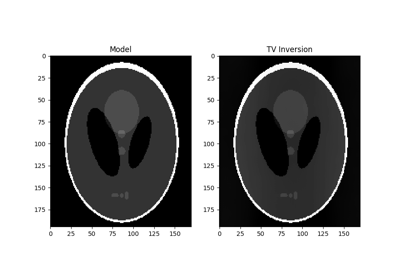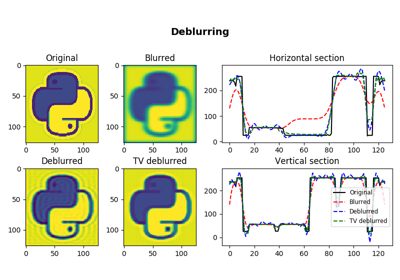pylops.optimization.sparsity.SplitBregman¶
-
pylops.optimization.sparsity.SplitBregman(Op, RegsL1, data, niter_outer=3, niter_inner=5, RegsL2=None, dataregsL2=None, mu=1.0, epsRL1s=None, epsRL2s=None, tol=1e-10, tau=1.0, x0=None, restart=False, show=False, **kwargs_lsqr)[source]¶ Split Bregman for mixed L2-L1 norms.
Solve an unconstrained system of equations with mixed L2-L1 regularization terms given the operator
Op, a list of L1 regularization termsRegsL1, and an optional list of L2 regularization termsRegsL2.Parameters: - Op :
pylops.LinearOperator Operator to invert
- RegsL1 :
list L1 regularization operators
- data :
numpy.ndarray Data
- niter_outer :
int Number of iterations of outer loop
- niter_inner :
int Number of iterations of inner loop
- RegsL2 :
list Additional L2 regularization operators (if
None, L2 regularization is not added to the problem)- dataregsL2 :
list, optional L2 Regularization data (must have the same number of elements of
RegsL2or equal toNoneto use a zero data for every regularization operator inRegsL2)- mu :
float, optional Data term damping
- epsRL1s :
list L1 Regularization dampings (must have the same number of elements as
RegsL1)- epsRL2s :
list L2 Regularization dampings (must have the same number of elements as
RegsL2)- tol :
float, optional Tolerance. Stop outer iterations if difference between inverted model at subsequent iterations is smaller than
tol- tau :
float, optional Scaling factor in the Bregman update (must be close to 1)
- x0 :
numpy.ndarray, optional Initial guess
- restart :
bool, optional The unconstrained inverse problem in inner loop is initialized with the initial guess (
True) or with the last estimate (False)- show :
bool, optional Display iterations log
- **kwargs_lsqr
Arbitrary keyword arguments for
scipy.sparse.linalg.lsqrsolver
Returns: - xinv :
numpy.ndarray Inverted model
- itn_out :
int Iteration number of outer loop upon termination
Notes
Solve the following system of unconstrained, regularized equations given the operator \(\mathbf{Op}\) and a set of mixed norm (L2 and L1) regularization terms \(\mathbf{R_{L2,i}}\) and \(\mathbf{R_{L1,i}}\), respectively:
\[J = \mu/2 ||\textbf{d} - \textbf{Op} \textbf{x} |||_2 + \sum_i \epsilon_{{R}_{L2,i}} ||\mathbf{d_{{R}_{L2,i}}} - \mathbf{R_{L2,i}} \textbf{x} |||_2 + \sum_i || \mathbf{R_{L1,i}} \textbf{x} |||_1\]where \(\mu\) and \(\epsilon_{{R}_{L2,i}}\) are the damping factors used to weight the different terms of the cost function.
The generalized Split Bergman algorithm is used to solve such cost function: the algorithm is composed of a sequence of unconstrained inverse problems and Bregman updates. Note that the L1 terms are not weighted in the original cost function but are first converted into constraints and then re-inserted in the cost function with Lagrange multipliers \(\epsilon_{{R}_{L1,i}}\), which effectively act as damping factors for those terms. See [1] for detailed derivation.
The
scipy.sparse.linalg.lsqrsolver and a fast shrinkage algorithm are used within the inner loop to solve the unconstrained inverse problem, and the same procedure is repeatedniter_outertimes until convergence.[1] Goldstein T. and Osher S., “The Split Bregman Method for L1-Regularized Problems”, SIAM J. on Scientific Computing, vol. 2(2), pp. 323-343. 2008. - Op :

